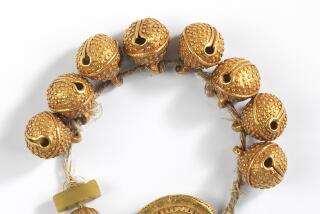‘Ernest Cole: Photographer’ opens at Fowler Museum
Long before Ernest Cole became one of South Africa’s first black photojournalists, he had dreams of becoming a doctor, a bold aspiration for a young man coming of age during apartheid rule in the 1950s and 1960s.
In an unpublished biography from late 1966 Cole wrote that it was a Baldafix folding camera in a drugstore window that caught his attention and set him on another path. A family friend lent him a twin lens reflex camera and he quickly began making money taking snapshots. Cole spent the next few years exposing the evils and social effects of life in South Africa. His series of disturbing images reveal passport arrests, “Europeans Only” signage and chaotic, cramped conditions on black-only commuter trains.
“Ernest Cole: Photographer,” an exhibition of 125 black-and-white photos, opens Sunday at the Fowler Museum at UCLA and runs through July 7.
FULL COVERAGE: 2013 Spring arts preview
Born in 1940 in Pretoria, Cole was self-taught via correspondence classes from the New York Institute of Photography. He wangled his way into Drum Magazine in Johannesburg, where he was taken under the guidance of picture editor Jürgen Schadeberg. With encouragement from photographer Alf Kumalo, he was soon freelancing for local and foreign news organizations, including the Associated Press and the New York Times.
“It was important to show his view and not make the picture the papers or magazines wanted him to do,” said Gunilla Knape, curator with the Hasselblad Foundation in Sweden, which holds Cole’s collection.
Early on, he decided to create a collection of pictures for a book recording apartheid from an insider’s perspective, emulating his idol Henri Cartier-Bresson’s 1955 book, “The People of Moscow.”
Timid and small in stature but highly disciplined and passionate, Cole often applied covert tactics such as hiding a camera in his jacket lining and outwitting the authorities by changing his classification from African to Coloured (mixed-race), which gave him more freedom to move about.
When he heard of the appalling conditions in the mines, he created a spy-worthy contraption to conceal his camera in a paper lunch bag. His image of naked black miners lined up for medical inspection facing a washroom wall, arms above raised high above their heads, is both powerful and courageous. “If you mention Ernest Cole’s name, I think most people would mention that photo or the white woman on the ‘Europeans only’ bench,” said Knape.
It was a series of a white off-duty traffic cop dancing with a black woman that brought attention to Cole’s concealed identity and eventually led to his exile to the United States in 1966. Although his book “House of Bondage” was published in 1967, it was bittersweet, because it was banned in South Africa. Cole had trouble assimilating to his new environment despite help from Cornell Capa of Magnum Photos in gaining assignments about the civil rights movement.
“Homesickness and not being in his own environment might have meant that he didn’t have the same passion,” said Knape. Cole wrote of wanting to focus his talents on more joyful aspects of life, but he struggled mentally. He died homeless in New York in 1990.
MORE
INTERACTIVE: Christopher Hawthorne’s On the Boulevards
Depictions of violence in theater and more
PHOTOS: Arts and culture in pictures
More to Read
The biggest entertainment stories
Get our big stories about Hollywood, film, television, music, arts, culture and more right in your inbox as soon as they publish.
You may occasionally receive promotional content from the Los Angeles Times.






